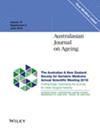The prevalence and correlates of depression and anxiety symptoms in older adults receiving in-home aged care: A cross-sectional survey
Abstract
Objectives
To estimate the prevalence of depression and anxiety symptoms in older Australians accessing in-home aged care, and to identify characteristics associated with symptoms.
Methods
A cross-sectional telephone survey with a random sample of in-home aged care clients from a national provider (Silverchain) was conducted between November 2022 and July 2023. The percentage of clients experiencing depression and anxiety symptoms was estimated, weighted to the age and gender of the Silverchain population. Multivariable linear regression was utilised to identify characteristics associated with higher depression and anxiety symptoms.
Results
A total of 237 participants completed the survey. Over half (52%) of participants experienced symptoms of depression (≥5 on the PHQ-9), while 16% experienced clinically meaningful symptoms indicative of probable major depressive disorder (≥10 on the PHQ-9). Over one-third (37%) of participants experienced symptoms of anxiety (≥5 on the GAD-7), while 12% experienced clinically meaningful symptoms indicative of probable generalised anxiety disorder (≥10 on the GAD-7). Most clients (61%) experienced symptoms of depression and/or anxiety, with 29% experiencing co-morbid symptoms. Younger age, lower quality of life, higher loneliness, living in a major city (compared with rural/remote areas) and living with family (compared to living alone) were associated with higher levels of depression or anxiety symptoms in this cohort.
Conclusions
Symptoms of depression and anxiety are common in older Australians accessing in-home aged care, with many experiencing co-morbid symptoms. In-home aged care providers are ideally situated to identify and facilitate treatment and monitoring for these individuals.

 求助内容:
求助内容: 应助结果提醒方式:
应助结果提醒方式:


